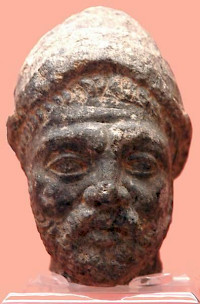Arsaces XIV, Mithradates III
Arsaces XIV, Mithradates III: Arsacid king during a brief "dark period" in the history of the Parthian Empire (r.87-80/79).

After the long and succesful reign of the Parthian king Mithradates II, Gotarzes I would have been the logical successor: son of a great king, member of a legitimate dynasty, grown-up and experienced. However, when he became king in 91 BCE, he already had a rival: a distant relative named Sinatruces had revolted in Elam (93/92).
This marks the beginning of what scholars call the "dark period" in Parthian history, which lasted about three decades. It took the new king, whose power base was in the north, quite some time to remove the rebel. Several months after his final victory in 88/87, however, Gotarzes' own reign came to an end.
He was succeeded by Mithradates III, whose accession is mentioned in a cuneiform source. He may have been a son of Mithradates II and a brother of Gotarzes. During the first months of his reign, he intervened in the civil war between the Seleucid rulers Demetrius III Eucaerus and Philip I Philadelphus in Syria, supporting the latter during when he was besieged in Beroea (Aleppo). Mithradates lifted the siege and arrested Demetrius, who died in captivity.
While this was an undeniable succes, the Parthian relations with Armenia suffered. Its king Tigranes II, once a hostage at the Parthian court, had been an ally of both Mithridates II and Gotarzes I, but he now invaded the Parthian territories and occupied several northern provinces: Atropatene, Arbela and Nineveh in Adiabene, Gordyene, and Osrhoene.note
In the spring of 80 BCE, a new pretender rose: Orodes I. (The date is exact: in the first month of his reign, the Astronomical Diaries from Babylonia mention the lunar eclipse of April 11.) Later, Orodes was enthroned in Susa. What happened to Mithradates III has not been recorded.
Note
The chronology of the Arsacid kings of the Parthian Empire is less well-understood than, for example, the sequence of Seleucid and Ptolemaic kings or the emperors of Rome. This information is based on the researches by G.R.F. Assar, as published in "Iran under the Arsakids, 247 BC – AD 224/227" in: Numismatic Art of Persia (2011).